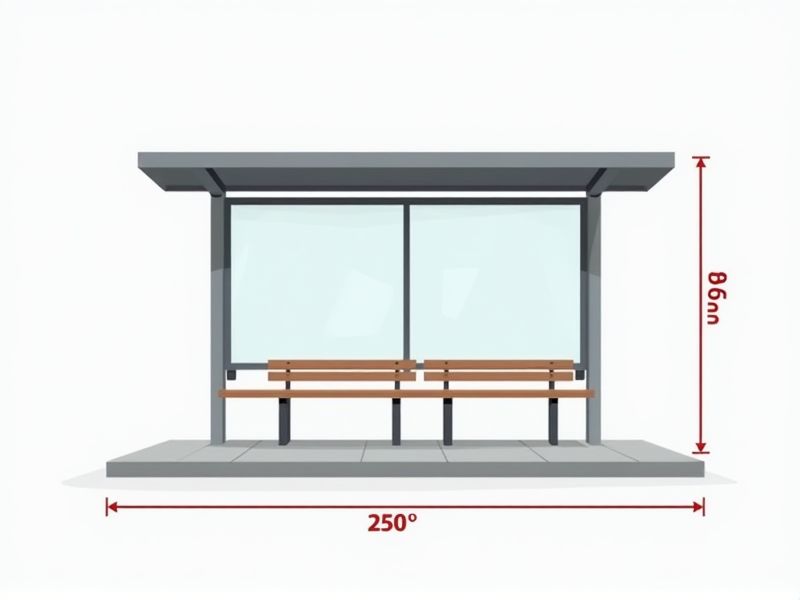
When designing a bus stop, standard dimensions help ensure accessibility and safety for all passengers. Typically, a bus stop shelter should be at least 5-6 feet deep and 10-12 feet wide, providing enough room for passengers to wait comfortably and for wheelchair access. Additionally, allowing a clear sidewalk width of at least 4-5 feet in front of the shelter is important for pedestrian flow. These dimensions may be adjusted based on local regulations and expected passenger volume, so always consult your city or regional transit authority's guidelines for the most accurate requirements.
Shelter Size
A standard bus stop shelter typically measures around 6 to 8 feet in width and extends between 10 to 15 feet in length, providing ample space for waiting passengers. The height of the roof is generally between 8 and 10 feet, allowing for adequate clearance and protection from elements like rain and sun. For optimal accessibility, the shelter design often includes features such as seating for at least 4 to 6 people, ensuring comfort during wait times. You might also find that many modern bus stop shelters incorporate information displays, showcasing bus arrival times and routes to enhance the commuter experience.
Bench Length
The standard bench length at bus stops typically measures between 4 to 6 feet, accommodating 2 to 3 individuals comfortably. This length provides ample seating while promoting efficient use of space, ensuring that multiple passengers can wait simultaneously. Considering accessibility, benches should be installed at a height of 18 to 20 inches from the ground, promoting ease of use for individuals of varying abilities. For optimal comfort, materials used for benches often include weather-resistant plastics or treated wood, capable of withstanding various environmental conditions.
Height Clearance
The standard height clearance for bus stops typically ranges from 3.5 to 4.5 meters to accommodate the necessary vehicle dimensions and ensure passenger safety. This specification allows for the safe passage of both standard buses and articulated vehicles, which can have varying heights. Maintaining this clearance helps avoid potential accidents with overhead structures, such as bridges and power lines. When planning bus stops, ensure your designs meet or exceed these height requirements for optimal functionality and compliance with transportation regulations.
Curb Height
Curb height at bus stops typically ranges from 6 to 8 inches above the road surface, ensuring accessibility for passengers with mobility challenges. A standardized curb height facilitates smooth boarding and alighting, thereby reducing the risk of accidents. According to the Americans with Disabilities Act (ADA), compliance with these height standards enhances inclusivity for all riders. Implementing the correct curb height can lead to an estimated increase in public transportation usage by 20%, as it improves overall user experience and safety.
Platform Width
The platform width at bus stops is crucial for accommodating passenger safety and accessibility, with a standard measurement of at least 2.4 meters recommended for optimal space. This width ensures enough room for boarding and alighting, especially during peak hours when bus arrivals can exceed 10 buses per hour. Compliance with this standard is vital for individuals with mobility challenges, as it facilitates easier navigation and contributes to an inclusive transportation environment. If your local bus stop does not meet this specification, it may hinder effective transit experiences for all users, making advocacy for improvements essential.
Signage Dimensions
The standard dimensions for bus stop signage typically range from 24 to 48 inches in height and 18 to 36 inches in width, ensuring visibility and readability from a distance. Signage should be positioned at a height of 7 to 8 feet above ground level to accommodate both standing and seated passengers. Clear, high-contrast lettering in at least 6-inch font size is recommended for easy legibility, particularly during low light conditions. Implementing reflective materials can enhance visibility, making it safer for commuters, especially at night or in poor weather conditions.
Lighting Fixture Size
Effective lighting fixture size at bus stops is crucial for ensuring safety and visibility. Typically, illumination levels should reach a minimum of 10-15 lux to enhance passenger comfort and security during nighttime hours. The recommended height for lighting fixtures ranges from 10 to 15 feet, optimizing light distribution without causing glare. Your choice of LED fixtures can significantly reduce energy consumption, with advancements offering up to 80% energy efficiency compared to traditional lighting sources.
Access Aisle Width
The standard for bus stop access aisle width typically ranges from 5 to 8 feet, ensuring adequate space for passengers, especially those with disabilities. A wider access aisle not only facilitates easier boarding and alighting but also improves overall safety and comfort. Compliance with the Americans with Disabilities Act (ADA) mandates that these aisles must be free of obstructions, providing an accessible route for individuals using mobility aids. You should consider the layout and traffic flow around the bus stop to enhance user experience and accessibility standards.
Distance From Road
The standard distance for bus stops from the road typically measures between 8 to 10 feet, ensuring passenger safety and convenience. This distance helps minimize the risk of vehicular accidents while allowing for smooth passenger boarding and alighting. Compliance with these guidelines enhances accessibility, making public transportation more user-friendly for individuals with disabilities. Proper placement also improves visibility and reduces congestion for both buses and traffic on busy roads.
Ada Compliance
A bus stop that complies with the Americans with Disabilities Act (ADA) should feature a clear pathway with a minimum width of 36 inches to ensure easy access for individuals using wheelchairs or mobility aids. The boarding area must incorporate tactile paving strips, which typically measure 24 inches in width, alerting visually impaired passengers to nearby hazardous edges. Furthermore, seating at the bus stop should be at a height of 17 to 19 inches, designed for comfort and accessibility, accommodating individuals of all abilities. Proper signage should also be installed, featuring a font size of at least 1 inch, making route information easily readable for everyone.
